| Battle of Purandar | |||||||||
|---|---|---|---|---|---|---|---|---|---|
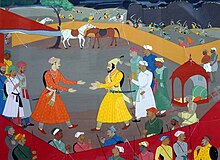 | |||||||||
| |||||||||
| Belligerents | |||||||||
| | | ||||||||
| Commanders and leaders | |||||||||
| | | ||||||||
| Strength | |||||||||
| Unknown | 12,000 [1] | ||||||||
The Battle of Purandar was fought between the Mughal Empire and the Marathas in 1665.
| Battle of Purandar | |||||||||
|---|---|---|---|---|---|---|---|---|---|
 | |||||||||
| |||||||||
| Belligerents | |||||||||
| | | ||||||||
| Commanders and leaders | |||||||||
| | | ||||||||
| Strength | |||||||||
| Unknown | 12,000 [1] | ||||||||
The Battle of Purandar was fought between the Mughal Empire and the Marathas in 1665.
The Mughal Emperor, Aurangzeb, appointed Jai Singh to lead a 12,000-man army against Maratha king Shivaji. Shaista Khan and Muazzam were both replaced by Jai Singh after their failure against Shivaji. Jai Singh was given full military power and made viceroy of Deccan by the Mughal Emperor. [1]
Jai Singh started his campaign by isolating Shivaji; he persuaded some Maratha nobles to join him and offered to reduce the tribute of the Bijapur Sultanate if they joined him. Jai Singh then besieged Purandar and beat off all Maratha attempts to relieve the fort. In 1665, Shivaji surrendered and agreed to hand over 23 of his 36 forts to Jai Singh.A mansab of 5000 was granted to shivaji's son, Sambhaji. [3] Shivaji refused to personally serve Aurangzeb, but agreed to send his son Sambhaji. Shivaji also agreed to help the Mughals against Bijapur. Shivaji, along with his son Sambhaji, was taken as prisoner at Agra in 1666. [4]
After the treaty, Jai Singh sent Shivaji against Bijapur as he feared that Diler Khan and other Mughal officers might harm Shivaji. After the failed campaign against Bijapur, Jai Singh arranged a meeting between Aurangzeb and Shivaji, which proved to be a disaster, allowing Shivaji to escape and a renewal of the war between the Mughals and the Marathas. [1]
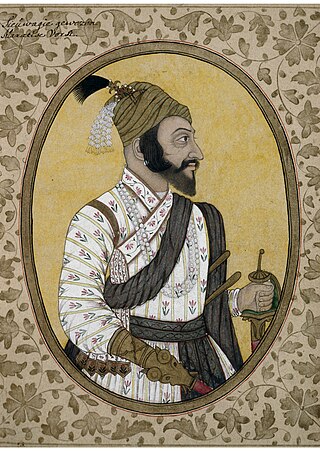
Shivaji I was an Indian ruler and a member of the Bhonsle dynasty. Shivaji carved out his own independent kingdom from the declining Adilshahi Sultanate of Bijapur that formed the genesis of the Maratha Empire. In 1674, he was formally crowned the Chhatrapati of his realm at Raigad Fort.

Sambhaji, also known as Shambhuraje was the second Chhatrapati of the Maratha Kingdom, ruling from 1681 to 1689. He was the eldest son of Shivaji, the founder of the Maratha Kingdom. Sambhaji's rule was largely shaped by the ongoing wars between the Marathas and the Mughal Empire, as well as other neighbouring powers such as the Abyssinians of Janjira, Wadiyars of Mysore and the Portuguese Empire in Goa. After Sambhaji's execution by Aurangzeb, his brother Rajaram I succeeded him as the next Chhatrapati and continued the Mughal–Maratha Wars.
Netoji Palkar (1620–1681), also known as Netaji Palkar, served as a prominent Maratha general and held the esteemed position of the 3rd Senapati of the Maratha Army under the leadership of Chhatrapati Shivaji, the visionary founder of the Maratha empire.
Murarbaji Deshpande was a general in the early Maratha Empire during the reign of Chatrapati Shivaji. He is best remembered for his defense of the Purandar Fort against Dilir Khan, a Mughal general who accompanied Jai Singh I in the 17th-century siege on Purandar.

Balaji Vishwanath Bhat was the first of a series of hereditary Peshwas hailing from the Bhat family who gained effective control of the Maratha Empire and the Mughal vassals of the Marathas during the early 18th century. Balaji Vishwanath assisted a young Maratha king Shahu to consolidate his grip on a kingdom that had been racked by civil war and persistently intruded on by the Mughals under Aurangzeb. He was called the Second Founder of the Maratha State. He secured a grant from the Mughal court that confirmed Shahu as the legitimate Mughal vassal, at the expense of his rival Sambhaji. Later, his son Bajirao I became the Peshwa.

The Deccan wars were a series of military conflicts between the Mughal Empire and the descendants of the Maratha ruler Shivaji from the time of Shivaji's death in 1680 until the death of Emperor Aurangzeb in 1707. Shivaji was a central figure in what has been called "the Maratha insurgency" against the Mughal state. Both he and his son, Sambhaji, or Shambuji, typically, alternated between rebellion against the Mughal state and service to the Mughal sovereign in an official capacity. It was common practice in late 17th-century India for members of a ruling family of a small principality to both collaborate with the Mughals and rebel.
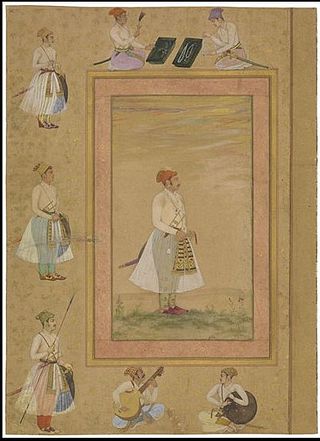
Mirza Raja Ram Singh I was the Raja of the Kingdom of Amber and head of the Kachwaha Rajput clan, succeeding his father Mirza Raja Jai Singh I. He also served as the general of the Mughal Empire and commander-in-chief of its army as well as the Subahdar of Kashmir.

The Battle of Sinhagad, also known as Battle of Kondhana, involved an attack by Marathas during the night of 4 February 1670 on the fort of Sinhagad, near the city of Pune, Maharashtra. The Marathas captured the fort.

Mirza Abu Talib, better known as Shaista Khan, was a Moghul General and the Subahdar of Mughal Bengal, he was maternal uncle to the Moghul Emperor Aurangzeb, he acted as a key figure during his reign, Shaista Khan initially governed the Deccan, where he clashed with the Maratha ruler Shivaji, However, he was most notable for his tenure as the governor of Bengal from 1664 to 1688, Under Shaista Khan's authority, the city of Dhaka and Mughal power in the province attained its greatest heights. His achievements include constructions of notable mosques such as the Sat Gambuj Mosque and masterminding the conquest of Chittagong. Shaista Khan was also responsible for sparking the outbreak of the Anglo-Mughal War with the English East India Company.
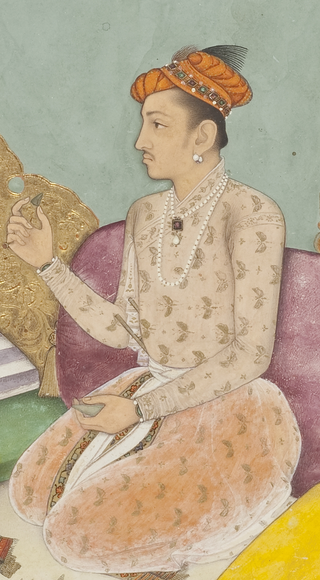
Mirza Raja Jai Singh I was the senior most general and a high ranking mansabdar at the imperial court of Mughal Empire as well as the Kachwaha ruler of the Kingdom of Amber. His predecessor was his grand uncle, Mirza Raja Bhau Singh, the younger son of Mirza Raja Man Singh I.

Purandar Fort is a mountain fort in Pune district in Western Indian state of Maharashtra, India. The fort stands at 1,374 metres (4,508 ft) above the sea level in the Western Ghats, 50 kilometres (31 mi) to the southeast of Pune.

The siege of Bijapur began in March 1685 and ended in September 1686 with a Mughal victory. The siege began when Aurangzeb dispatched his son, Muhammad Azam Shah, with a force of nearly 50,000 men to capture Bijapur Fort and defeat Sikandar Adil Shah, the then ruler of Bijapur, who refused to be a vassal of the Mughal Empire. The siege of Bijapur was among the longest military engagements of the Mughals, lasting more than 15 months until Aurangzeb personally arrived to organize a victory.

The siege of Jinji,, began when the Mughal Emperor Aurangzeb appointed Zulfiqar Ali Khan as the Nawab of the Carnatic and dispatched him to besiege and capture Jinji Fort, which had been sacked and captured by Maratha Empire troops led by Rajaram, they had also ambushed and killed about 300 Mughal Sowars in the Carnatic. The Mughal Emperor Aurangzeb then ordered Ghazi ud-Din Khan Feroze Jung I to protect the supply routes leading to Jinji Fort and to support and provide reinforcements to Zulfiqar Ali Khan when needed.

Diler Khan Daudzai was a Mughal general who served under Aurangzeb and was the governor of Awadh. He is known to battle and kill Murarbaji, the military general of Shivaji and the in-charge of Purandar Forts. His brother's name was Nawab Bahadur Khan. Nawab Diler Khan and his brother Nawab Bahadur Khan together established the famous district Shahjahanpur located in Uttar Pradesh. He was also responsible for the Mughal victory over Shivaji in the Battle of Bhupalgarh.
The Battle of Salher was fought between the Marathas and the Mughal Empire in February 1672 CE. The battle was fought near the fort of Salher in modern day Nashik district. The result was a decisive victory for the Marathas. This battle is considered particularly significant as it is the first pitched battle where the Mughal Empire lost to the Marathas.
Savitribai Deshmukh, better known by her title Rai Bagan or Raibagan, was a female Mughal general under the Emperor Aurangzeb. She was the widow of the Mughal sardar Raje Udaram Deshmukh of Mahur jagir in Deccan. After her son's death in Battle of Samugarh, she led her forces aiding the then prince Aurangzeb in the battle, which paved his way to become the emperor. The emperor conferred upon her the royal title. She aided Aurangzeb's uncle Shaista Khan in the Mughal campaign against the Maratha empire's founder Shivaji.
Mughal invasion of Konkan (1684) was a part of the Deccan wars. It was a campaign launched by Mughal Emperor Aurangzeb to capture the Konkan region from the Maratha ruler Sambhaji. The Mughal forces were led by Mu'azzam and Shahbuddin Khan. The harsh climate and the Maratha guerrilla strategy forced the numerically strong Mughal army into a slow retreat. The Maratha army suffered small losses in this unsuccessful campaign of Mughal Empire.

Bahadur Khan, Khan Bahadur or, Bahadur Khan Kokaltash was a foster-brother to the Moghul Emperor Aurangzeb, he was the Subahdar of Lahore, Burhanpur and Deccan, Aurangzeb had two foster-brothers he was one of favourite, another foster-brother Fidai Khan Koka, they three didn’t blood-related but fosterage to eachothers, Bahadur was the Senior General of the Mughal Empire and closer companion to the Emperor Aurangzeb, he was the one of Military Commander of Mughal who defeat Marathas in three major battles but lose one only, as also he involve in Mughal-Maratha wars (1681–1707). he was buried in his tomb located in present Pakistan Tomb of Bahadur Khan, his father Mir Abu’l-Ma'ali was given title of Sayyid-e Khafi" by Padishah Aurangzeb Alamgir, through his son Shah Quli Khan, he have grandson Alivardi Khan the Nawab of Bengal.
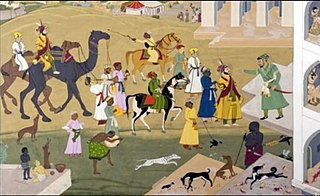
The Execution of Sambhaji was a significant event in 17th-century Deccan India, where the second Maratha King was put to death by order of the Mughal emperor Aurangzeb. The conflicts between the Mughals and the Deccan Sultanates, which resulted in the downfall of the Sultanates, paved the way for tensions between the Marathas and the Mughals. Following the death of Shivaji, his son Sambhaji ascended to the throne and conducted several campaigns against the Mughals. Unlike his father, Sambhaji tolerated instances of rape and murder committed by his army during these conflicts. This led Aurangzeb to launch a campaign against the Marathas, resulting in the capture of the Maratha King by the Mughal general Muqarrab Khan. Sambhaji and his minister Kavi Kalash were then taken to Tulapur, where they were tortured to death.

Shivaji's Southern campaigns are also defined as Maratha invasion of Karnataka and Dakshina Digvijaya campaigns. Following his coronation as sovereign ruler, Shivaji faced a tumultuous period marked by the loss of his trusted advisor and mother, Jijabai, and escalating conflicts with neighboring powers.
After the disgrace of Shaista Khan and Shivaji's raid on Surat....Aurangzeb appointed Mirza Raja Jai Singh, who was one of his trusted noble...he was given an army of 12,000.....Jai Singh was not only given full military authority....he was made the viceroy of the Deccan in place of Prince Muazzam...in order to isolate Shivaji, and even tried to win over the Sultan of Bijapur....he also induced some of the Maratha deshmukhs...marching to Pune, Jai Singh decided to strike at the heart of Shivaji's territories....Jai Singh closely besieged Purandar, (1665) beating off all Maratha attempts to relieve it. With the fall of the fort in sight, and no relief likely from any quarter, Shivaji opened negotiations with Jai Singh.
After Jai Singh had promised him a safe conduct Shivaji proceeded on the morning of 24th June 1665, to meet the R^put general in his camp. Jai Singh, however, sent word that unless Shivaji agreed to surrender all his forts, he need not come for an interview. Shivaji agreed and proceeded on and was welcomed at the door of the tents by Jai Singh's Bakhshi. Jai Singh biznself advanced a few steps, embraced Shivaji, and seated him by his side. Jai Singh had instructed Diler Khan and Kirat Singh to bunch an attack on Purandar, while Shivaji was with him so as to convince the latter of the hopelessness of the Maratha position.